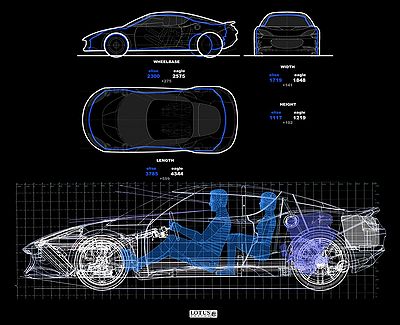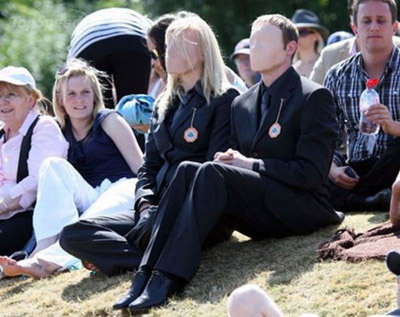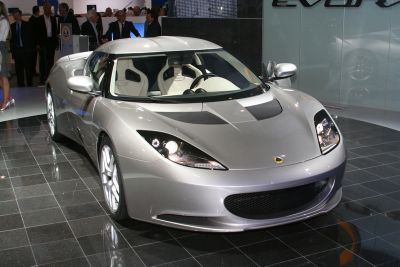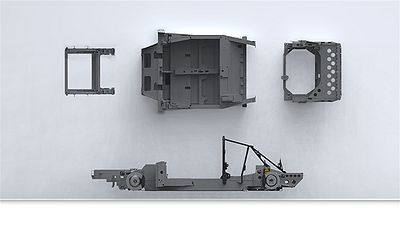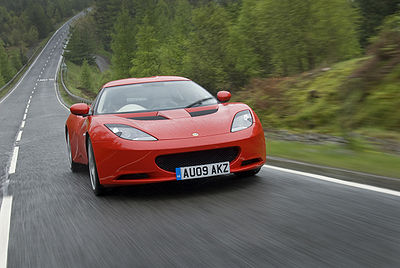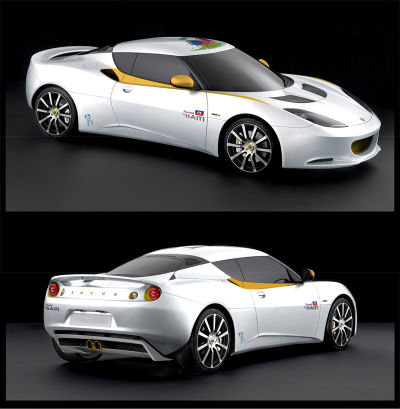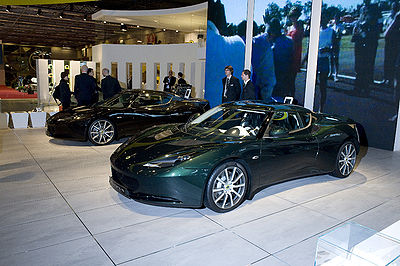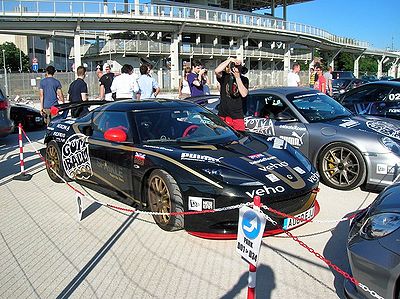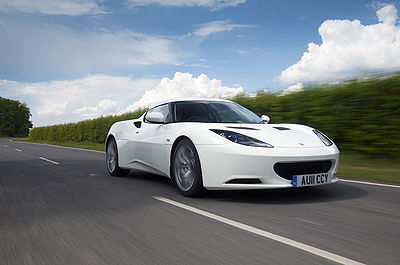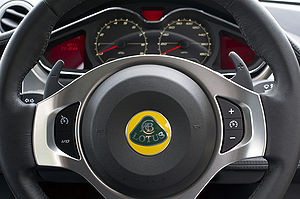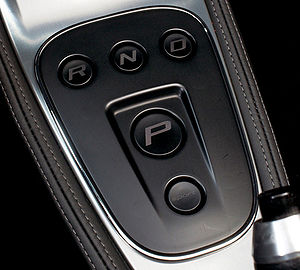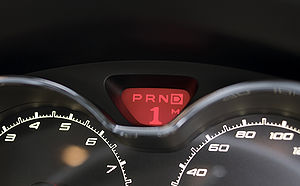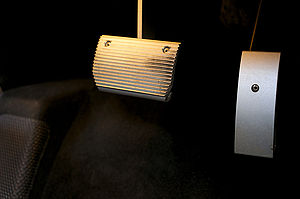Models - Evora
Pre-launch
Known as Project Eagle during its development the Evora is Lotus's first ever mid-engined 2+2, although the default configuration is actually the "+0", with the rear seats an optional extra.
In the run up to it's launch Lotus carried out a promotion campaign promising "True Character in a Faceless World", which included people with blank face masks appearing at Wimbledon, the Henley regatta and Elton John's white tie and tiara ball.1
This promotion lead to the website http://www.facelesspeople.com, which featured nothing but a countdown to the cars launch and a link back to the Group Lotus website. Since the launch this site has been removed and is no longer available.
The unveiling of the Evora on the 22nd of July at the 2008 British International Motor Show2 marked Lotus's first all-new car since the Elise in 1995. Although Lotus had produced models such as the Exige, Series 2 Elise and Europa in the interim period these were still fundamentally based on the original Elise platform.
As with the 'Federal' Elise the Lotus Evora was designed with international sales in mind, in particular the lucrative US market. This was deemed vital to help Lotus reach a wider audience of more affluent buyers, with the Evora looking to compete against a far wider range of cars than the Elise's niche appeal.
Parallels could certainly be drawn between the Evora launch and that of the original Elite and Esprit, with Lotus looking to produce cars that would push up market and could command higher pricing and, hopefully, profit margins...
At the launch Lotus where bullish, talking of how the car had been developed in just 18 monthsCitation needed, and of projected sales figure of around 2,000 cars per year worldwide.
Platform Architecture
As with the Lotus Elise the Evora chassis is formed from bonded aluminium extrusions, a technique which Lotus pioneered with the Elise.
Unlike the Elise however the Evora chassis based around Lotus's VVA chassis architecture.3
This is built is made up of three separate sections, the central tub, the front and rear, which are then joined together (bolted?) to form the completed chassis.2
This not only eases repairs - in the Elise if the suspension pick points are damaged in a crash the whole chassis will often be written off, where as with the Evora the damaged section can be removed and replaced - but also saves time in the cars construction, with the sections able be built simultaneously before being joined together once all three are completed.
This approach could also ease future developments where, for example, a new power train was to be utilised which necessitates a change to the rear of the car. In this case production of the front and centre sections could be carried out as per normal with rear sections being attached to meet demand and/or build schedules when the chassis was completed.
Evora Models
At present all models of the Lotus Evora share the same coupe body shape and are all powered by derivatives of the Toyota 2GR-FE V6 engine.
Early cars, particularly the Launch Edition models, have been noted as having some interior build quality issues, but these have been steadily improved.
Evora
After its unveiling in July 2008, the first customer Evora was sold to Matthew Melling, a customer of Stratton Motor Company, in September 2009.4
The initial run of 450 cars delivered were all the Launch Edition models, which were produced to a fixed specification to ease the initial production process.
After this regular production began, with both the Evora 2+0 and 2+2 available with a range of option and upgrade packs.
| Layout | Transverse mid engined, rear wheel drive |
| Length | 4342 mm |
| Width | 1848 mm |
| Height | 1223mm |
| Engine fuel | Petrol |
| Engine configuration | V6 |
| Engine capacity | 3456 cc |
| Engine power | 276hp (280PS/206KW) at 6400 rpm |
| Engine torque | 258lb/ft (350Nm) at 4600 rpm |
| Engine rev limit | 6400rpm (7000rpm with Sport Pack) |
| 0-60mph (0-100 km/h) | 4.9 seconds (5.1 seconds) |
| Top speed | 162mph (261kph) |
| CO2Emissions | 199g/km (215g/km with Sports Gearbox) |
| Weight | 1382kg |
| Seats | 2 (with option of 2+2) |
| Transmission | 6 speed manual (Optional Sports Gearbox) |
| Drive | RWD |
Launch Edition
The Evora Launch Edition made up the first 450 (200 destined for the UK) production Evora's. They were all built to the same specification, allowing Lotus to bring the production line up without having to worry about the various different permutations possible with customised cars.
All Launch Editions came equipped with 2+2 seating, Tech Pack, Premium Pack, Sport Pack, Hi-power silver cast alloy wheels, Bi-Xenon Headlamps, Alpine Imprint Audio System, Reversing Camera, Electric Powerfold Mirrors and a numbered plaque. The Sport Ratio gearbox was not an option on Launch Edition cars, with the only options being the cars paint and possibly interior trim.5
The Evora Launch Edition was priced at £58,460, with Metallic, Lifestyle and Premium paint colours as cost options.
Naomi for Haiti
Following the earthquake that struck Haiti in 2010, Lotus donated eight special edition Evora's to be auctioned off at Naomi Campbell's Fashion for Relief show, held at Somerset House on February 18th, during London Fashion Week.
The "Naomi for Haiti" cars were based off the standard Evora, and featured a unique livery designed by Lotus Design Director, Donato Coco, which "reflects Naomi’s design direction.".
The cars raised over €1.4 million towards relief efforts6, with the first 2 cars selling for over £300,000 each.
Press reception
The Evora launched to positive reception from the press, with 5-star reviews in Evo7 and Car8 magazines.
Reviews praised the Evora's ride and handling, but raised some concerns as to whether the build quality was up to the level of its rivals. "It has proved to be a really usable GT car, yet it has also played the junior supercar role in a way I hadn’t expected. It still hasn’t got the feeling of solidity that Porsche imbues in its cars, but as a package the Evora has a lot of similarities with the multi-talented 911."
Awards
Autocar - Britain's Best Driver's Car 20099
Car Magazine - Performance Car of the Year 200910
Evo - Car of the Year 200911
Evora S
Officially unveiled at the Paris Motor Show on September 30th 2010 alongside the Evora IPS. It's launch was somewhat overshadowed however as Lotus chose the same event to unveil this 'New Era' range of concept cars, prompting concerns that the Evora would quickly be replaced by the new Elan. These concerns were later allayed with the Elan later scheduled for 2017 and Lotus committing to continuing the evolution of the Evora range.
The most obvious enhancement from the base Evora is the addition of an Eaton Roots-type Twin-Vortices supercharger helping the Evora S produce 345bhp, but the Evora S also receives the Sport Pack, cross drilled brakes and Stealth Grey Classic Wheels as standard, along with revisions made to areas such as the gear shift linkage.
| Layout | Transverse mid engined, rear wheel drive |
| Length | 4342 mm |
| Width | 1848 mm |
| Height | 1223mm |
| Engine fuel | Petrol |
| Engine configuration | V6 with Supercharger |
| Engine capacity | 3456 cc |
| Engine power | 345hp (350PS/257.5KW) at 7000 rpm |
| Engine torque | 295lb/ft (400Nm) at 4500 rpm |
| Engine rev limit | 7000rpm |
| 0-60mph (0-100 km/h) | 4.6 seconds (4.8 seconds) |
| Top speed | 172mph (277kph) |
| CO2Emissions | 235g/km |
| Weight | 1437kg |
| Seats | 2 (with option of 2+2) |
| Transmission | 6 speed manual |
| Drive | RWD |
Evora S Gumball
A one off car created by Lotus for the 2011 Gumball Rally 3000 and driven by Tamer Hassan.
Based on the standard Evora S the Gumball car was enhanced with a range of cosmetic and mechanical changes borrowed from the Evora GT4 race car. These included the full GT4 aero package of front and rear bumpers, front diffuser, rear splitter and wing, air intake, barge board and grills, along with the GT4 exhaust, wheels, 4-way adjustable Ohlin dampers, stiffer Eibach Race springs, and a 30mm lower ride height - although road tyres were retained to keep the car road legal.
Evora IPS
Launched alongside the Evora S at the Paris Motor Show on September 30th 2010, the Evora IPS paired the normally aspirated Toyota 2GR-FE engine with the Toyota U660E gearbox.
The Toyota U660E gearbox is a traditional torque-converter automatic gearbox, and unlike the manual is only available with the standard Toyota specification gear ratios. This is paired with Lotus's own electronics to give the gearbox a more sporting feel.
Inside the car sees the removal of the tradition gearstick, replaced with a panel for switching between Reverse, Neutral, Drive and Park, along with the Sport button. Paddles are fitted behind the steering wheel, with left paddle changing down and the right changing up. In the instrument binnacle the small LCD used to show the fuel level is re-purposed to show the current gear selection and mode. In the foot-well, as you'd expect, there are only two pedals.
Sport mode in the Evora IPS changes the way the gearbox reacts, both in terms of the chosen gear and the amount of time the car will remain in Manual mode after a paddle has been used. It does not however increase the rev limit due to the limitations of most torque converter automatic gearboxes.
| Layout | Transverse mid engined, rear wheel drive |
| Length | 4342 mm |
| Width | 1848 mm |
| Height | 1223mm |
| Engine fuel | Petrol |
| Engine configuration | V6 |
| Engine capacity | 3456 cc |
| Engine power | 276hp (280PS/206KW) at 6400 rpm |
| Engine torque | 258lb/ft (350Nm) at 4600 rpm |
| Engine rev limit | 6400rpm |
| 0-60mph (0-100 km/h) | 5.3 seconds (5.5 seconds) |
| Top speed | 155mph (250kph) |
| CO2Emissions | 208g/km |
| Weight | 1436kg |
| Seats | 2 (with option of 2+2) |
| Transmission | 6 speed automatic |
| Drive | RWD |
